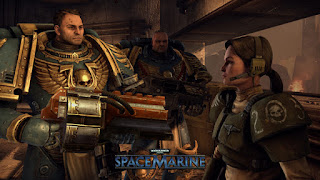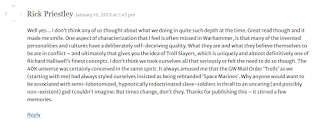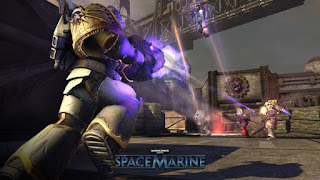 |
| Games Workshop/Sega |
Though the property grows increasingly prominent outside of wargaming miniature circles, Warhammer 40,000 doesn't have much to show for it video game wise. There are two big exceptions; Real Time Strategy classic Dawn of War and the third person, melee heavy shooter Space Marine.
The player controls Captain Titus of the Ultramarines, a chapter of the superhuman warriors known as Space Marines. His company is dispatched to the Forge World Graia, one of the foundries that supply the galaxy spanning Imperium's endless wars and now the site of a full scale Ork invasion. It's up to Titus to save Graia, now a ruined planet on the brink of defeat, though more dangerous foes may yet lie in wait.
Published by the now defunct THQ, Space Marine is one of the AA games that have largely gone extinct, overshadowed by gargantuan, big name undertakings and surprise Indie hits. And Space Marine is certainly middle of the road.
 |
| Games Workshop/Sega |
Gameplay wise, Space Marine finds a nice balance between melee and raged options. Titus' main gun is the iconic bolter, which in this game is a compromise between the rocket powered explosive launcher of the lore and the lower caliber assault rifle seen in most adaptations.
The game cleverly translates other tabletop weaponry into shooter staples. The anti-tank melta gun is akin to most shooters' shotguns and the lascannon serves as a sniper rifle best used for tankier ranged enemies. It's a good mix of weapons that are satisfying to use and benefit from some excellent sound design, adding to their existing weight.
Melee weapons are less varied. Though the four options receive different animations, most feel like cosmetic changes outside of damage output, barring the appropriately unwieldy but capable Thunder Hammer.
Enemy wise there's even less of a mix, though that's partially because the source material leaves them in a tight spot, though the lack of character model variation draws attention to it. Combat mainly boils down to dispatching large waves of axe wielding enemies,
though the game puts more emphasis on ranged opponents as it progresses. Everything feels faithfully represented and even lasguns get some long awaited respect.With a regenerating shield and health bar, Space Marines get they're legendary durability, even on higher difficulties. It's appropriately satisfying to rely on your guns as you wait for your shields to recharge before you rush back into the fray, chainsword revving. Melee attacks fill up your Fury meter, which you can activate when full for a powered up state. Health is restored by executing staggered enemies in flashy, gore drenched animations. Lesser foes, like diminutive grots, are simply punched into a red mist, serving as walking health packs.
 |
| Games Workshop/Sega |
The few boss fights are forgettable and the game ends on a whimper with an awkward quick time event sequence. That the final antagonist is so lacking in personality adds to the sense of anticlimax.
The level design is just about adequate, though it fails to come up with some anything truly inspired. With the limited mechanics, it falls into the classic shooter trap of consisting entirely of hallways and arenas.
The handful of high flying jump pack segments are a nice departure from that, though they feel a bit clunky and too brief.
Developers Relic Entertainment at least made the most of the resources on hand, mainly through strong art direction and a surprisingly memorable orchestral soundtrack. The environmental design is excellent, somewhat alleviating the subpar level design with the perfect mix of gothic features, archaic technology, and massive scale that defines Warhammer 40K.
The late 2000s/early 10s shooter genre's obsession with murky greyish-brown ruins turns out to be a good fit for the Dark Millennium. Space Marine also doesn't entirely shy away from bright lighting and colors, especially for the characters.
But at 10 years old, Space Marine feels its age. Repeated textures are common and even when playing on good hardware you'll pick up on some middling character models and blurry sky boxes. The skin and faces look decent enough, though expressions are very limited. Unfortunately the armor and fabric is lacking. That's not an issue in the swirling melees and roaring gunfire, where particle effects are put to good use but the cutscenes offer no reprieve.
 |
| Games Workshop/Sega |
The presentation as a whole is very cinematic: the Michael Bay-esque camera angles in cutscenes, the dramatic aerial and wall-smashing entries, how the story quickly moves from one gargantua setpiece to the next. It made the setting digestible to a wider audience, without losing any of the "cool" parts.
At least, not on the surface.
Unfortunately, I found Space Marine to offer a surface level view of the setting. The plot is as basic as it gets and even the twist is predictable to Warhammer fans. By the same merit, I'm not sure how much sense it makes without prior context, with how little the game does to explain it. The characters are all very one note and the dialogue is almost exclusively exposition. You'll notice how many lines of dialogue repeat various faction names.
The few themes present are barely explored, a shame since Space Marine sets up an ongoing conflict between loyalty, duty, and orthodoxy that gets largely drowned out in bolter fire and bloodshed.
 |
| Source |
In Space Marine's defense, the game makes some effort to convey the larger setting and it's myriad of horrors, though it's quite literally in the background. Audio logs reflect the dire fates and oppressed lives of the people who once inhabited the game's smouldering ruins. In one of Space Marine's more effective touches, an automated voice lectures long dead workers for abandoning their posts and rebukes decreased productivity at destroyed assembly lines.
Even the ending tries to course correct, showing that no one ends up happy in this future, not even the "heroes."
 |
| Games Workshop/Sega |
Even so, Space Marine gets too caught up in gruesome spectacle to touch on Warhammer's nuances. That might be what made the game so accessible and gave it such staying power for fans.
But ten years since the game's release, Games Workshop had to clarify the galaxy spanning fascist theocracy are not the good guys, in response to a spate of racist incidents in the fandom. In light of that ongoing issue, I wonder how much that perception of the Imperium can be blamed on many fans' first experience with Warhammer 40K being media like Space Marine.
There, the attention is on how Titus is a power armored hero saving largely unseen mere mortals, not a living weapon serving "the cruellest and most bloody regime imaginable," as the tabletop game's legendary intro text goes.
Keeping that in mind, I still think Space Marine is a fun game for fans and newcomers alike, with pulpy, fast paced combat and a memorable atmosphere. It's a shame the game's multiplayer is long dead, as it offered deathmatches between space marines and their Chaotic counterparts, along with a game mode where a team of four held off hordes of adversaries. With Space Marine 2 announced, there's a chance to resolve the game's decade long cliffhanger and offer an improved version of an already satisfying experience.
I only hope they remember who the villains are this time around.
No comments:
Post a Comment